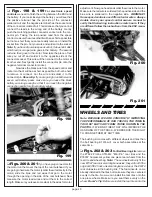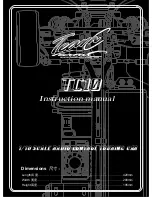
page 55
page 55
Associated has recently released our new #711
Reedy Car Wash, which cleans both your car and Lexan
body. It is biodegradeable and Lexan safe but cannot be
used to clean motors or electronics.
TUNING TIPS
You have several different adjustments on your
RC10T, some of which can be used to tune the truck for
different tracks or conditions.
DIFFERENTIAL ADJUSTMENT. Once the differen-
tial has been correctly adjusted, there should be no need to
change it until rebuilding time. (1) Bottom out the diff spring
and diff screw, being careful to be extremely accurate
when backing the screw out 1/8 to 1/4 turn. (2) On a new
or just-rebuilt differential, apply a small amount of throttle
while holding one of the rear wheels stationary. Do this for
about 15 seconds. This will correctly seat all of the differential
parts. (3) Now recheck the diff adjustment by again following
step 1 above.
TORQUE CLUTCH ADJUSTMENT. It is possible to
over-tighten the torque clutch. If you do, you may damage the
diff gears when landing off a jump. To prevent this, take your
time when making clutch adjustments. On a new or just-rebuilt
torque clutch, run the setting a little on the loose side for about
one minute before readjusting to race settings. It is important
to keep in mind that spinning the tires is not putting the power
to the ground. With a fully charged battery you should only
have about three to six inches of wheel spin (the tire actually
spinning across the top of the surface) to get maximum
advantage of the torque clutch. On a high traction surface you
can adjust the torque clutch a little tighter than you would on
a low traction surface. Remember: the purpose of the
clutch is to gain traction, not to break the tires loose.
CASTER (fig. 215) describes the angle of the king-
pin, in relation to the vertical plane, when looked at from the
side of the car. As an example, 0° of caster puts the kingpin
in a vertical line. Positive caster means the kingpin leans
rearward at the top.
Caster has several effects; however, the easiest way
to see its effects is to compare it to the casters on the bottom
of a shopping cart. When the cart is pushed forward, any
misalignment of the casters will cause a side load on the
wheels and thus cause the wheels to realign in the direction
of travel. Increasing the positive caster on your car will
increase the steering turning into a corner and slightly de-
crease steering coming out of the corner. Reducing the
positive caster will decrease the amount of steering you have
going into a corner and increase the amount of steering you
have in the middle of the corner and exiting the same corner.
Associated makes positive caster blocks in increments of 5°
starting at 5° and going through 30°. Your RC10T2 truck
comes with 30° caster, front carrier blocks, which is what we
recommend for off road racing. The 30° of caster will give you
good steering going into the corner but take away just enough
steering coming out of the corner so that the truck will have
less tendency to oversteer when accelerating out of the
corner. The increased caster also gives you more stability on
fast, bumpy track conditions.
30° positive caster
negative caster (not used)
Fig. 215
ADJUSTMENT:
Change front block carriers.
EFFECT:
Reducing caster: decreases steering into corners, in-
creases steering at middle and end of corners.
Increasing caster: Increased steering at beginning of
corners, more understeer out of corners.
RECOMMENDED: 30° caster.
POSITIVE CASTER OPTIONS: #6211, Front block carrier,
5° caster. #6212, Front block carrier, 10° caster. #6213,
Front block carrier, 15° caster. #6214, Front block carrier,
20° caster. #6215, Front block carrier, 25° caster. #6210,
Front block carrier, 30° caster, included in kit.
CAMBER is a word describing the angle at which the
tire and wheel rides relative to the ground when looked at from
the front or back (fig. 216). This is one of the most important
adjustments on the truck. Negative camber means that the tire
leans inward at the top, putting it closer to the centerline of the
truck than the bottom of the tire. Positive camber means just
the opposite, the top of the tire is further away from the
centerline of the truck than the bottom of the tire.
Excessive negative camber will take away traction
but increase stability. Positive camber will also take away
traction but decrease stability. A tire's maximum traction is
achieved when it is perpendicular to the ground (straight up
and down). For the rear tires this will cause understeering in
most conditions and possibly traction rolling in high traction
conditions. We suggest a starting setting of 2° of negative
camber for both front and rear. If you want to add a little more
steering, reduce front camber to 1° negative or even 0°. Keep
in mind that using little or 0° of camber will cause the truck to
slide unpredictably. Try to use at least 1 to 2° negative camber
at all times. This can be adjusted by turning the upper control
rod turnbuckles (front or rear) in the appropriate direction.
positive camber
negative camber
Fig. 216




































